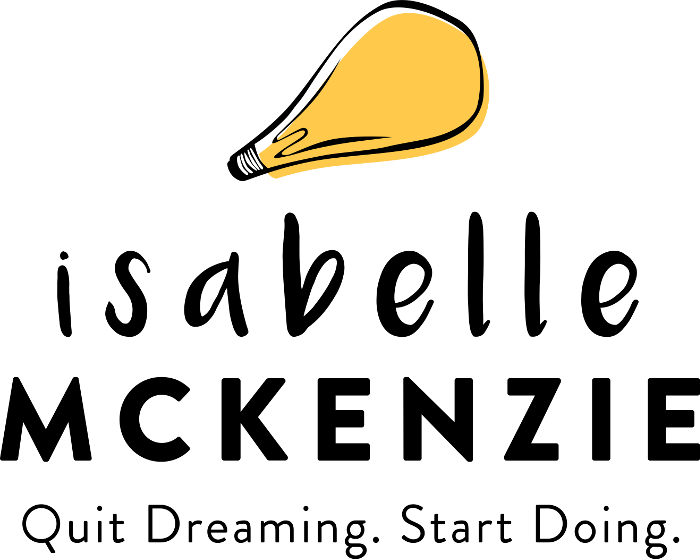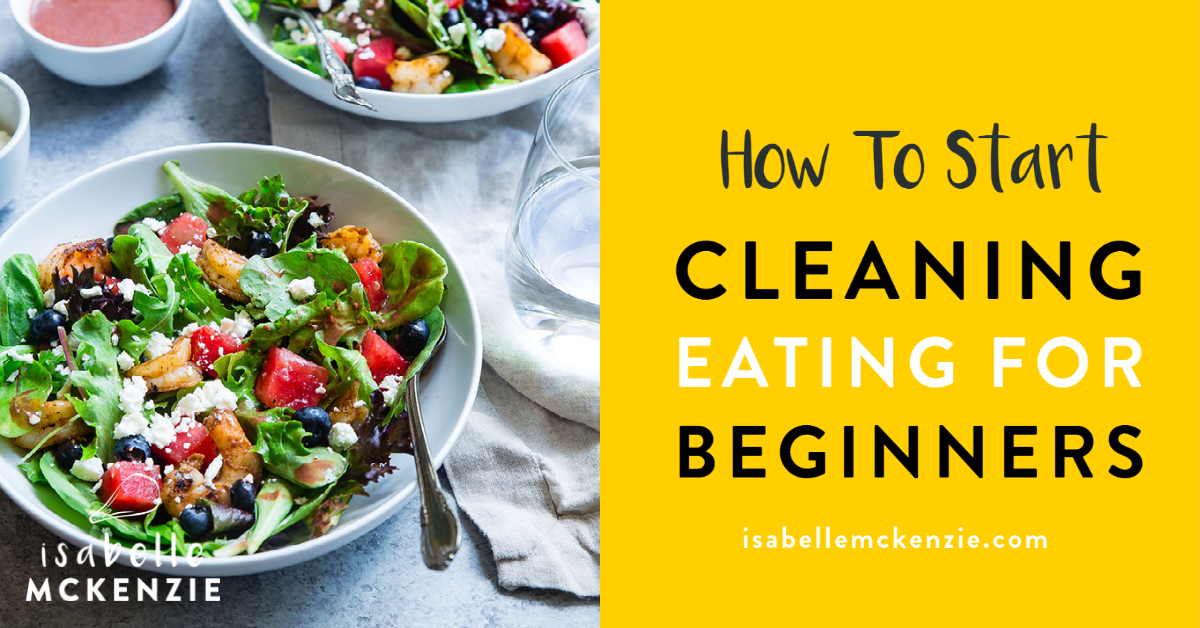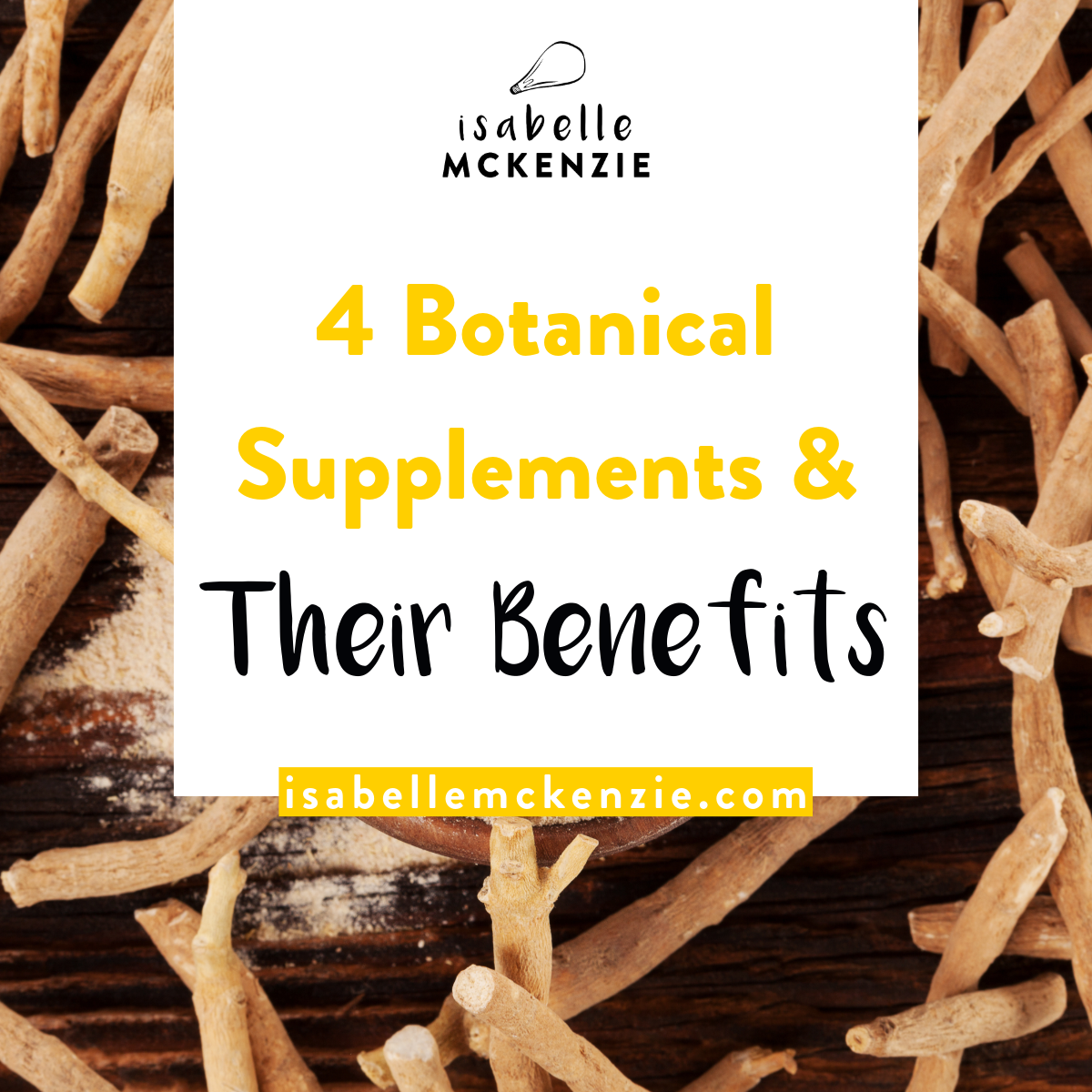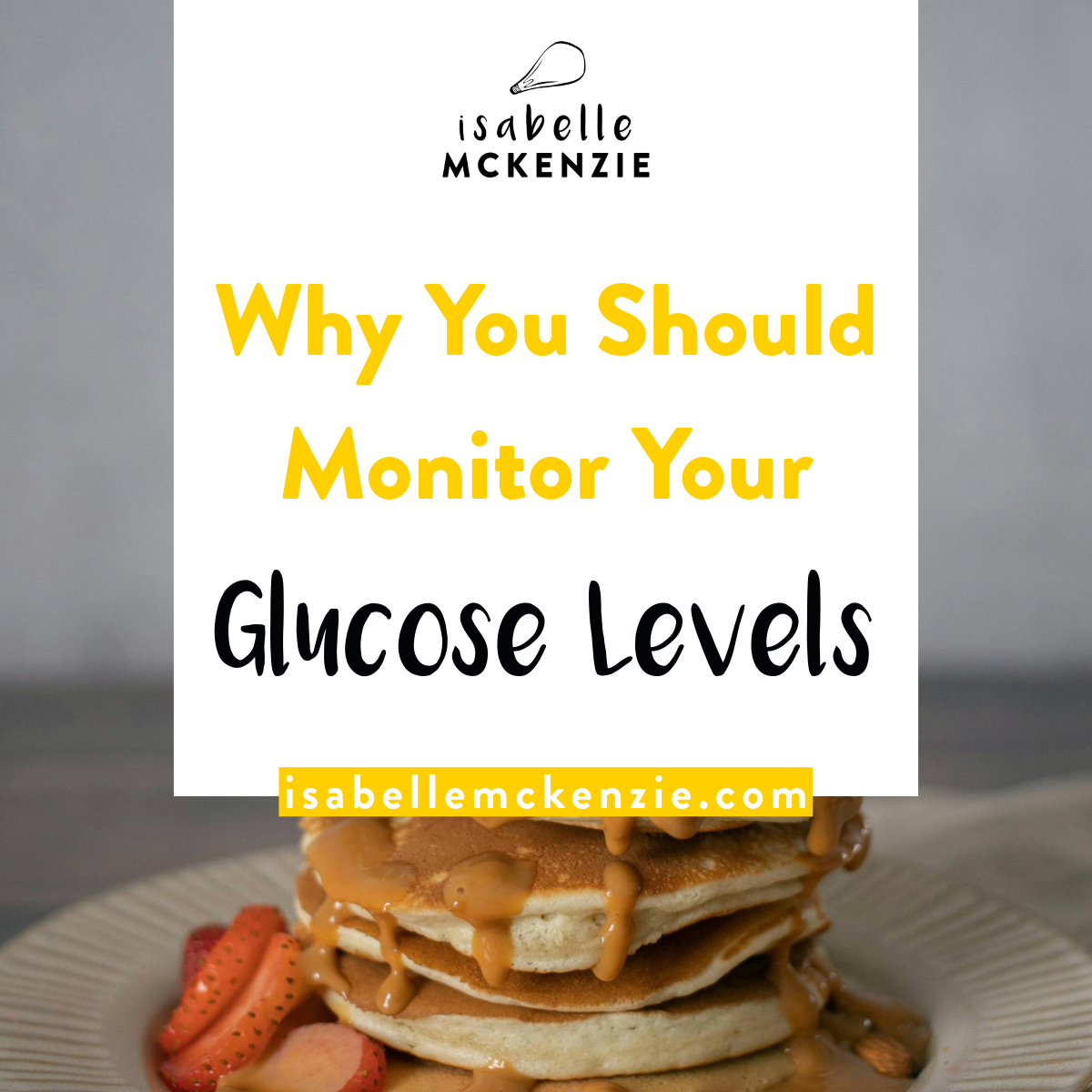How To Start Clean Eating For Beginners
#SugarBalancedLiving
What is clean eating, and how do you do it? Well, clean eating doesn't actually have anything to do with food being clean or dirty, it’s simply avoiding processed ingredients and embracing a natural diet lifestyle! Here’s the full rundown on what clean eating is, how to do it, and why you should start. We’ve broken down the process of clean eating for beginners so you can understand it and start if it’s right for you!
Have you heard about the rise of clean eating? Maybe your friends have mentioned it before, or maybe you've seen nutritionists praise the clean ways of eating? But have you brushed it off as another new faddy diet?
Yep, the nutrition and diet world can be pretty confusing, tiring, and even toxic for your mental health. The term "clean eating" can feel negative or like it's implying that other foods are "dirty. If “clean eating” is a thing then does that mean that “dirty eating” is a thing? Ugh, that doesn't sound nice. However, this is not the case.
While the phrase "clean eating" can sometimes feel negative, it is anything but that.
What Is a Clean-Eating?
There are a great many definitions of the term clean eating. However, they all stem from a core concept of consuming a healthy diet.
Clean eating simply means filling your plate with healthy whole foods like veggies, fruits, whole grains, lean proteins, and healthy fats. These types of foods will fill you with important minerals and nutrients and keep intake of processed foods like added sugars and hydrogenated fats to a minimum. Clean eating is simply a purely natural way of eating.
We certainly need this natural way of eating when we consider the fact that one in four Americans eat fast food every day and that processed foods make up close to 70 percent of the U.S. Diet. Frozen fruits and vegetables count as processed, but as you can imagine, frozen whole foods can only account for so much in that 70 percent, making this a shocking statistic.
And that’s not the end of it. Americans spend 10 percent of their disposable income on fast food. That means processed food affects both your health and your wallet.
Heavily processed foods lack nutritional value and include excessive amounts of sugar, sodium, and fat. Most processed foods are usually engineered to be hyper-palatable so that they taste really good. They also contain high amounts of calories and cause significant blood sugar imbalances - known factors that can cause endless food cravings.
Consuming too many processed foods that are high in sugar, processed fats, and have a high glycemic index, can lead to serious health issues like obesity, heart disease, high blood pressure, and diabetes.
For this reason, decreasing your intake of heavily processed foods and eating more high-quality nutritious foods will help you to achieve a healthier more vibrant you. Therefore, the concept of cleaning up your diet, including more whole foods, and ditching processed ingredients is rooted in good advice.
That is why the basic core concept of clean eating is a great general guide to living a healthier life and this is why clean eating has quickly become one of the most popular diets and healthy living philosophies around.
I’ve become very familiar with clean eating recently as I've come to realize that following my own healthy sugar-balanced nutritional rules was pretty much following many of the clean eating guidelines without even knowing it.
However, there is one annoying snag when it comes to following a clean eating diet - it doesn’t have one set of guidelines which can make it tricky for someone to try to follow it like a 'typical diet' (think: keto, vegan, etc.).
If you’re new to the idea of eating clean and not sure where to start, don't worry, I'm here for you, I've got you covered. The goal is to help you feel your best, and sometimes you need someone to guide you through the steps and processes to help you easily apply it to your life. Let’s take a look at the most common principles of clean eating and find out everything you need to know about this trendy eating style.
Why You Should Start Eating Clean?
Before we get started with ironing out some guidelines for what a clean eating diet should look like, I understand that considering a clean eating diet may seem daunting, but I want to quickly show you how the many fantastic benefits might far outweigh any concerns you may have when attempting to eat clean. Here are the reasons why you need to embrace the principles of clean eating as soon as possible:
1. Weight Loss and Maintaining a Healthy Weight
One fantastic perk of eating foods that are as natural as possible is that your body tends to thrive and stay slim pretty much effortlessly.
When you follow a clean eating diet, you're naturally consuming fewer empty calories and foods that are rich with filling nutrients like fiber. Fiber is significant in weight loss as it helps your body regulate hunger and cravings by making you feel fuller for longer durations than normal.
2. You’ll Save Money
Eating healthy can not only make you slim down, but it can also be great for your wallet. Opting for more nutritious real foods can help reduce medical costs and help you skip all those sick days.
Consuming plenty of fruits and vegetables doesn’t only increase your immunity in the short term, but it also helps prevent disease in the long run. Eating more veggies has been shown to reduce your risk of heart disease, which afflicts about a third of all adults and costs about $444 billion a year to treat in the U.S according to the Centers for Disease Control and Prevention.
So basically a clean eating diet means that you're more likely to stay healthy during flu season and get that paycheck (or promotion), and you won’t have to spend money on meds and extra doctor’s visits.
Plus, since you'll be planning clean meals for the week, it's cost-effective since you won't go overspending at the store and you'll be avoiding pricey restaurants and unhealthy takeout orders.
3. A Boost In Heart Health
A clean eating diet supports your long-term health, as a healthy diet helps lower your risk of cardiovascular disease.
As we talked about earlier, if you eat a lot of processed foods, then chances are you are consuming too much sugar, bad fat, and salt. These elements are known to contribute to increased cholesterol and blood pressure. As a result, you are at higher risk of heart attacks and strokes. Clean eating will reduce the amount of processed and refined foods in your diet.
Not only are you less likely to have increased risk of cardiovascular diseases or stroke when you eat less processed foods, but also the high amounts of nutrients in fruits and vegetables in a clean eating diet will help lower your risk of coronary heart disease risk and also protect against stroke and high blood pressure.
4. Improved Happiness
Food and mood go hand in hand. The better the quailty and nutrition in the food you consume, the better your mood will feel.
Since up to 90% of your body's serotonin is produced in your gut, it is believed that a healthy gut may correspond to a good mood. Healthy eating also helps keep your blood sugar stable, which will help maintain your mood throughout the day.
How To Start Clean Eating (for Beginners!)
The secret to understanding eating clean for beginners is to think of it as more of a philosophy and lifestyle rather than a “diet,” instead of having eating clean as a getting skinny quick kinda "diet." Instead, clean eating is a way to approach how you eat and what you put in your body daily.
Eating clean is refusing to continue to put junk in your body, choosing to remove processed foods, artificial flavors, unnecessary fats, sugars, and refined carbs from your diet, and making better, smarter, healthier nutritious choices for your body.
In short, clean eating is a lifestyle approach that emphasizes whole foods while minimizing processed foods. Although, because clean eating can seem so loosely defined, the definition widely varies.
While clean eating can be interpreted as “less processed” by allowing minimally processed packaged foods with simple ingredients like whole-grain bread, Greek yogurt, apple sauce, etc, while restricting more heavily refined foods like soda, white bread, and frozen yogurt, some of the stricter clean eating diets will only allow organic whole foods and completely ban packaged foods, artificial ingredients, and preservatives.
Other strict interpretations may see clean eating as a diet clear of soy, dairy, wheat, eggs, nuts, and other modernized food ingredients.
There is a decent amount of diversity among the “clean eating community” concerning what the definition of clean eating actually is. However, for me, my favorite thing about the clean eating approach to food is that it’s not some calorie-restricted diet that leaves you feeling deprived. It’s about finding a healthy balance and enjoying food while staying nutritious.
So, I’m going to share my interpretation of clean eating and what I feel are the most realistic and beneficial aspects of the clean eating diet. Here my complete guide to clean eating foods for beginners or people looking to live healthier with a balance!
Clean Eating For Beginners
1. What You Need To Avoid
As you've probably realized by now, one of the most important principals of clean eating is eating food in it’s most natural whole food state posssible and avoiding unnecessary processed foods and additives, that are high in added sugars, sweetners, salt, artificial sweeteners, sugary beverages, such as soda and juice, alcohol, chemical additives like food dyes and sodium nitrite, foods with preservatives, refinied carbs, and high in bad fats (including awful fat like trans fats), and low in fiber and whole grains.
Examples of processed foods include candies, cupcakes, pastries, chips, fruit snacks, frozen dinners, breakfast cereal, canned soups, bacon, granola bars, etc.
I know that cutting your intake of foods you love like doughnuts, hamburgers, and candies may seem like a daunting task, but trust me it'll be worth it. This love and those cravings for junk foods is an addiction... yes, you heard me right: sugar and refined carb addiction is a real thing.
Studies have shown that sugar fires up dopamine and lights up your brain in the same manners as drugs, and there’s gotta be a problem with that - especially given the issues that come with high sugar consumption – problem is I have had first hand experience with.
I used to have a full blown sugar and junk food addiction - I was in really bad shape, both physically and mentally - so I certainly know the signs of an unhealthy relationship with the stuff.
A study published in the American Journal of Clinical Nutrition suggests that high sugar, high glycemic foods are just as addictive as table sugar.
David Ludwig and his colleagues at Harvard, conducted a study showing that foods that raise blood sugar even more than table sugar such as white flour, white potatoes and refined starch, have a high glycemic index, and trigger a region in the brain “nucleus accumbens” which is the area in the brain that is ground zero for a drug abuse addiction.
Because foods that spike your blood sugar are addictive, they don’t even have to be traditional ‘sweets’. This includes again: white bread, pasta, bagels, pastries, pretzel, sodas, and even sweeteners like maple syrup and coconut sugar.
When you experience sugar and refined carb addiction, this can of course cause endless hunger and cause you to never feel satiated.
Most people don’t even realize that they have sugar addiction, and that is actually one of the main reasons why you binge eat.
To cut back on sugar and carb addiction and/or cravings, I recommend you head over to my two blog posts: Am I Addicted to Sugar? 8 Ways to Know If You’re a Sugar Addict + How to Stop It and Am I Addicted To Carb? + Here's Everything You Need to Know! are two in-depth blog posts here to help you recognize signs of food addiction, find out whether or not those cravings are in fact sugar or carb addiction, and get the some pretty awesome steps to help in crushing carb and sugar intake.
I also have a free guide that’ll help you get started on effortlessly breaking your sugar reliance/addiction for good with help + support. AND, most importantly, while maintaining a healthy balance between your mind and your body - because low-sugar living shouldn’t feel like deprivation. Check out my FREE ‘Ultimate Guide to Crushing Your Sugar Cravings’ Downloadable Guide below.
2. What To Eat
Whole foods should make up most of your daily diet. The term whole food normally applies to foods that haven’t been modified, meddled within a manufacturing plant, and haven’t been heavily processed or refined, with no added sugars, preservatives, or dyes.
Whole foods include fresh fruits and vegetables, lean proteins, unsalted nuts/seeds, whole grains, full-fat healthy fats dairy products like Greek yogurt, and dried beans/legumes.
Since clean eating is more of a healthy eating philosophy than a specific diet plan, there are no calorie limits or specific things you must eat when following a clean eating diet.
Aim to fill half of your plate with lean protein and fiber-rich carbs, add at least one serving of healthy fats, and fill the other half of your plate full with non-starchy vegetables
Although the basic principles of clean eating center around eating whole and natural foods and removing processed and refined foods, however, it is helpful to have specific examples of what is generally foods allowed on clean eating:
• Whole vegetables and fruits
• Lean unprocessed meat, poultry, and seafood
• Nuts and seeds
• Natural oils like olive oil and coconut oil
• Vinegars
• Butter and ghee
• Fresh and dried spices
• Unsweetened pure nut butters
• Greek yogurt, full-fat plain yogurt, whole milk, almond milk, coconut milk, pure cottage cheese
• Eggs
• Less processed grains and legumes including barley, buckwheat, spelt, millet, quinoa, beans, whole brown rice, amaranth
3. What Is Your Macro?!
If you want your clean eating diet to work for your health goals like weight loss, weight gain, or weight maintenance, then the best way to achieve your fitness goals using the clean eating diet is to know your macro needs.
“Macro” is short for macronutrient.
What's a macronutrient?
They're the three categories of nutrients you eat the most and provide you with most of your energy: protein, carbohydrates, and fats. So when you're counting your macros, you're counting the grams of proteins, carbs, or fat that you're consuming.
Once you've calculated your macros to fit your needs for either weight loss, weight gain, or weight maintenance. From there, all you need to do is track your daily intake to ensure what you are eating is matching your nutrition needs.
Stay consistent and on track with your ideal macro intake and you will get results and achieve whatever your health goal is.
4. It's Time To Get Cooking
In this modern-day, it’s easier than ever to never have to cook at home: takeout, pickup, and numerous food-delivery apps make eating without cooking as easy as a tap on your phone.
However, if you cook at home you know exactly how much salt, sugar, flavors, and fats are in your dish and you have the power to swap ingredients in (and out) to fit your nutritional and caloric goals.
5. Nutrition Labels
The best trick in a healthy ninja’s arsenal (sorry I'm a bit of a geek) when buying packaged food is to simply check the label out!
When beginning with eating clean you need to get familiar with nutrition labels because they tell you everything you need to know about the foods you’re gonna eating. When you buy packaged foods, make sure to thoroughly read the labels - even savory foods can still contain plenty of sugar, from bread to salad dressings.
Pay attention to labels and look for foods with relatively few ingredients and appraise each ingredient in terms of whether or not it's an ingredient you would cook within your own kitchen. Avoid labels that include words that indicate added processing like “hydrolyzed” or “modified”.
If the food has a high-calorie content be sure to make sure that the saturated fat and especially trans fat and sugar levels are low. The calories should be coming from fiber, somewhat unsaturated fat, and lean protein instead.
Lastly, be wary of words that end in “-ose” because those usually suggest that it's an added sugar for example "dextrose" and "fructose". Food manufacturers use many sneaky ways to hide the amount of added sugar listed on nutrition labels. This can cause you to buy a food product with more sugar than you wanted, without even knowing it.
Find the full list of ‘sugar under another name’ in my guide 27 Hidden Sugar Foods to Watch Out for Checklist + Shopping Guide.
6. Don't Deprive Yourself
Labeling foods as “good” and “bad” or saying “no” to the foods you want forever can lead to excessive cravings, binge eating habits and can also cause you to dislike nutritious “healthy” foods.
There's no need to aim to deprive yourself constantly for days on end. Of course, you don’t have to completely deprive yourself of the treats you enjoy, the key is moderation, creating balance, taking back your control of cravings, and overall eating a balanced and nutritious diet.
Additionally, treat the process of shifting into a clean eating diet as a fun experiment and really get involved with what you're eating - don't just grab whatever's convenient and healthy all the time, explore and find nutritious foods and even healthy desserts that you enjoy eating.
The more you enjoy the process, the more likely you are to stick to it, and achieve lasting vibrant wellness!
To help you get started experimenting in the kitchen... I've got a whole recipe section full of my tried and tested Delicious Healthy & Sugar-Free Recipes for you to check out.
How To Get Started Eating Clean
Congrats on taking your first steps toward clean eating and therefore kicking off a healthier vibrant lifestyle. Eating clean can help you crush all the bad sugars, salts, and bad fats you don’t need and instead helps fill you with nourishing nutrients and gives you control over what goes in your body.
I know it can feel tempting to jump in to a new diet. But to start to take smaller steps, your body and mind need more of a gradual transition. For example, eat white bread every day for lunch, don't just drastically shift to a seeded 100% whole grain bread because you will hate your lunch.
Try by slowly changing your bread.
Like, start by firstly swapping to a higher quality white bread then swap that for seeded white bread or sourdough bread, and from there slowly work your way to a higher whole grain bread. Your tastebuds will start to change and you may find you don’t even want white bread in a week or two.
Trust me – you've got this. This is a lifestyle change, not some fad diet. Ease into it until you fully can embrace everything and it feels like normal to eat clean.
Of course, if you adapt well to the small changes feel free to make larger changes, everyone is different and how you feel is generally a good indicator of how well your approach is working for you.
If you do make drastic changes, especially if you were eating a fairly unhealthy diet before changing to a cleaner eating diet, you may notice a decrease in energy and side effects like cravings, increased hunger, and even headaches. But if you're getting the right nutrition and eating the right things, this should resolve itself over time and ultimately your energy levels, mood, and appetite will likely improve.
Eating clean gets easier and easier once you understand the basic concepts and shift your food choices over time.
Every healthy change you make is a positive change and, gradually once your body gets used to it, you will feel vibrant, energized, and glowing from the inside out.
Now, before you go… I know it can be hard going wholesome and removing processed and synthetic packaged foods from your diet, especially when they cause you to endless crave them. So, if your weight has crept up on you and/or you’re tired of feeling STUCK in trying to conquer negative food habits without food fads, obsessive dieting, deprivation, or the need for willpower, I have some extra support for you, that’ll help you in cutting down on processed foods and junk foods addictive pull!
Check out my FREE ‘Ultimate Guide to Crushing Your Sugar Cravings’ Downloadable Guide.
Get started on effortlessly breaking your sugar reliance/addiction for good with help + support. AND, most importantly, while maintaining a healthy balance between your mind and your body - because low-sugar living shouldn’t feel like deprivation.
Plus, for even more support, to help guide apply what you’ve learned about food today during your next shopping trip, I’ve put together a whole list of everyday innocent-looking foods that are hiding a surprising amount of sugar, in my '27 Hidden Sugar Foods to Watch Out for Checklist + Guide.














… yup, the Isabelle behind the IsabelleMcKenzie.com!
Instagram: @ItsIsabelleM | Pinterest: @ItsIsabelleM | Subscribe on Youtube
I’m dedicated to helping teach people how to live their happiest, healthiest life and reach their goals so that they can create the lifestyle of their dreams with integrity & purpose.
I focus on self-care, mind, body and health, dedicated to helping teach peeps how to live their happiest, healthiest life and reach their goals so that they can create the life that will have them jumping out of their bed in the morning to actually live!
Read More >